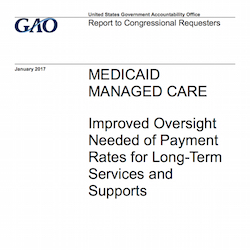
In the wake of findings detailed in a new report from the Government Accountability Office made public on Wednesday, the Centers for Medicare & Medicaid Services will take steps to ensure that states have sufficient incentives to use the billions of dollars they receive for the provision of Medicaid managed long-term services and supports.
If their payment structures are designed properly, MLTSS programs can enable states to expand community-based care and lower associated costs, the GAO said. CMS, however, does not consistently require states to report on whether those payment structures — payment rates, incentive payments and penalties — are achieving program goals, the GAO found.
The report recommended that CMS require all states to report on their progress in achieving MLTSS program goals. The Department of Health and Human Services agreed with the recommendation.
The GAO report also expressed concerns about the appropriateness and reliability of the data states use to set MLTSS rates. “To the extent that states use data that are not appropriate and reliable to set rates, the resulting rates could be too low, which could provide an incentive for [managed care organizations] to reduce care, or too high, which results in more federal spending than necessary,” according to the authors.
One state used data from 2010 and 2011 to set rates for 2015, the GAO found. Beginning in July, CMS will require rates to be based on the three most recent and complete years of data. CMS should establish criteria for what situations would warrant exceptions, however, the GAO said, to minimize the number of states using data of questionable appropriateness to set MLTSS rates. HHS agreed with the recommendation.
Also beginning in July, CMS will require states to validate encounter data. CMS has not issued guidance with minimum standards for state procedures, however, the GAO said, recommending that the agency do so to minimize the risk of encounter data being incomplete or inaccurate. HHS agreed with the recommendation.
The GAO prepared the report at the request of some members of Congress. It reviewed relevant federal regulations, guidance and internal control standards; reviewed program information in six states (Arizona, Delaware, Florida, Kansas, Minnesota and Texas); and interviewed CMS officials and Medicaid officials from the selected states.



